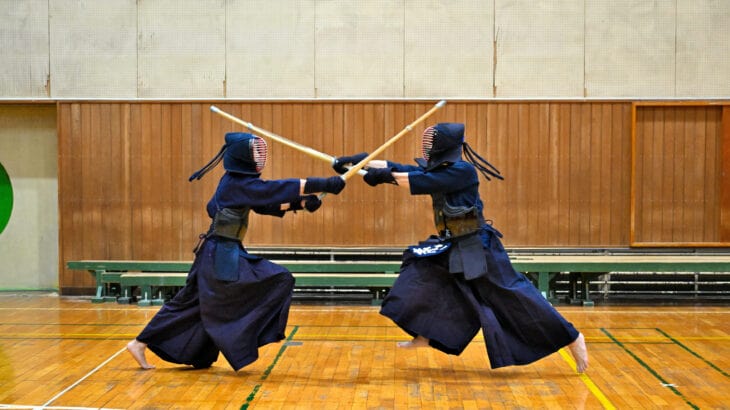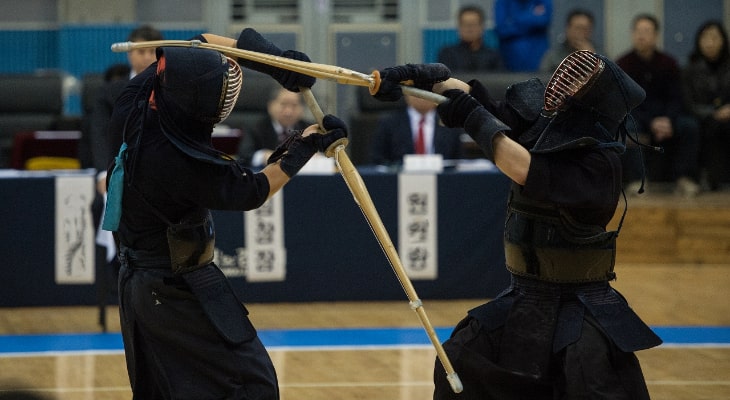
In kendo, “tsuba” plays an important role more than just equipment.
In this article, we will explain in detail the basics of Kendo Tsuba, how to choose it, how to attach it, and how to use it.
We will also delve into the types of Tsubasa, their functionality, and their tactical uses in Kendo, providing information that Kendo practitioners need to know to hone their techniques.
A useful guide for all Kendo practitioners, from beginners to experts, explaining the importance of Tsuba and how to use it effectively.
目次
What is Tsuba in Kendo?
In Kendo, the “tsuba” is located between the handle and the blade of a bamboo sword, and is an important part that protects the swordsman’s hand.
In this section, we will delve into the role and importance of the spittle, as well as its types and characteristics.
Role and importance of saliva
Kendo Tsuba is primarily used to protect the hands from the opponent’s Shinai during competitions.
This allows swordsmen to practice their techniques and compete safely.
Tsuba also provides a sense of psychological security when honing Kendo techniques, supporting an environment in which the swordsman can concentrate on his technique.
The presence of the brim is essential to complying with Kendo’s safety rules, and it plays a central role in the structure of the shinai.
Types and characteristics of brim
There are various types of kendo Tsubasa, each with different materials and designs. The main types of spit include:
- Plastic collar : The most common and recommended for beginners as it is durable and lightweight. It is also cheap and easy to obtain.
- Leather brim : More traditional and solid, but heavier and more expensive than plastic. It is highly durable and suitable for serious use.
- Metal brim : Very durable and heavy. It is mainly chosen by experienced and professional swordsmen.
These brims are selected depending on the style of the swordsman using them and the functionality required.
For example, a lightweight, easy-to-move plastic brim may be suitable for competition use, while a highly durable leather brim may be suitable for practice use.
Through this section, you will understand that the choice of brim when practicing Kendo is not just an accessory, but an important decision that has a direct connection to safety and performance.
Choosing the appropriate brim will not only improve your Kendo techniques, but will also greatly improve the safety of your practice.

How to choose a kendo brim
Tsuba in Kendo is more than just a protective device.
In this section, we will explain in detail the differences in materials and selection criteria when choosing a brim, as well as the balance between design and functionality.
Choosing the right brim will improve your kendo performance and also ensure protection.
Differences by material and selection criteria
Kendo brim is made from a variety of materials, each with its own characteristics and benefits.
- Plastic collar : Light and easy to handle, it is the most recommended material for beginners. Because it has a good balance between durability and cost, it is widely used for daily practice.
- Leather brim : It has a solid feel and is extremely durable. Because it can withstand long-term use, it is often chosen by advanced and professional swordsmen. Types of leather include horsehide, sharkskin, and buffalo leather, each with a different feel and weight.
- Metal collar : The heaviest material, especially able to withstand practical training and heavy blows. However, it is not recommended for general practice and may be used in specific forms or ceremonies.
When choosing materials, it is important to consider the intended use, personal preference, or frequency of practice.
Balance of design and functionality
The design of the brim is also important as an element that increases motivation in Kendo. There are many different designs on the market, and they are sometimes chosen as items to express individuality.
However, when choosing a design, it is most important not to compromise its functionality. In particular, the thickness and diameter of the brim have a direct impact on kendo performance, so you should take into consideration not only the appearance, but also the usability and protection ability.
Careful brim selection is recommended as it is directly related to Kendo safety and performance.

Correct way to attach kendo brim
In Kendo, correct attachment of the brim is essential to ensure safety and performance.
This section details the collar installation procedure and the types of collar stops and their uses.
This allows kendo practitioners to learn how to attach the brim correctly and safely, ensuring proper use.
Brim installation instructions
The steps to attach the Kendo Tsuba to the Shinai are as follows:
- Prepare the spit : Select the spit you will use and clean it. Make sure there are no scratches or cracks on the brim.
- Attaching the brim seat to the shinai : Slide the brim seat (the part that supports the brim) onto the base of the shinai handle.
- Putting the Tsuba on the Shinai : Place the Tsuba on the Tsuba seat and lower it along the handle of the Shinai.
- Attach the brim stop : Push the brim stop over the brim toward the handle of the shinai so that the brim is firmly in place.
Types of collar stoppers and their uses
The brim stop is an important part to secure the brim and ensure safety in Kendo. The main types of collar stops include:
- Rubber collar stop : This is the most common and easiest type to install. It is flexible and available at many sword supply stores.
- Silicone collar stop : More durable and more flexible than rubber. Can withstand repeated use.
- Leather brim stop : Traditional and durable, but can be a little fiddly to install.
When using a collar stopper, it is important to check that the collar is firmly secured and that it remains flexible. You should also regularly inspect the collar stops to ensure they are not deteriorating or damaged.
By properly implementing these installation procedures and usage methods, you can increase the safety of Kendo and manage your Shinai effectively.
Learn the correct knowledge and procedures and live a safe and comfortable Kendo life.

Technology of spit competition
In kendo, “tsuba competition” refers to a close tactical exchange that occurs between a swordsman and his opponent, and is an important phase in which a swordsman’s skills and psychological warfare are tested.
In this section, we will explain in detail the basics and tactics of Tsuba competition, as well as the role and things to keep in mind during the competition.
Basics and tactics of spit competition
Tsuba competition occurs frequently during Kendo matches, and is a technique used to find the optimal opportunity to attack while sensing the distance from the opponent. Basically, the following points are important:
- Distance Management : It is important to maintain accurate distance from your opponent and maneuver within your attack range. This allows you to maximize the effect when attacking and block your opponent’s techniques when defending.
- Distribution of force : In a spittle fight, it is necessary to devise a distribution of force so that you can move quickly when needed without using unnecessary force. You are required to remain relaxed and respond flexibly to situations without straining yourself too much.
Role and knowledge of saliva during competitions
Tsuba-kōgō plays a vital role in the tactics of kendo matches. A swordsman should have the following knowledge:
- Understanding psychological warfare : Spit fighting is more than just physical contact; it’s also a place to read your opponent’s intentions and apply psychological pressure. A swordsman must maintain his composure and use psychological warfare to create an advantageous situation without disturbing his opponent’s concentration.
- Tactical Variety : The ability to change tactics based on your opponent’s movements is also essential to success in spittle fighting. Rather than just one-sided attacks, looking for opportunities while solidifying your defense will increase your tactical depth.
Improving your Tsuba-Kyosai techniques is very important to gaining an advantage in Kendo matches.
This allows swordsmen to develop more advanced techniques and tactics, paving the way to success in matches.

How to care for and store Kendo Tsuba
Kendo brim requires proper maintenance and storage.
In this section, we will explain in detail how to maintain your spit and how to store it to make it last longer.
This information will help you enjoy Kendo safely for a long time.
How to maintain the brim
Kendo Tsuba maintenance includes the following steps:
-
Regular cleaning : Wipe the collar with a soft cloth after use, especially if it has sweat or dust on it. Plastic brim can be washed with water, but it is recommended to use a special cleaner for leather or metal brim.
-
Check for damage : Inspect the collar regularly for cracks, deformation, or signs of deterioration. Leather collars in particular can be protected by applying wax depending on how often they are used.
-
Deodorizing and disinfecting : If the brim is damp with sweat, dry it and then use a deodorizing and disinfecting spray to keep it clean. This is especially important in hot weather or after intense practice.
Storage tips to make it last longer
Proper storage of spit is important in extending its life:
-
Proper Drying : Dry the brim thoroughly after use. Leather items, especially those made of leather, can become moldy and damaged if stored in damp conditions.
-
Avoid direct sunlight : Avoid placing the collar in direct sunlight. UV rays can degrade the material.
-
Temperature and humidity control : It is desirable that the storage location has constant temperature and humidity. Environments with extremely high or low temperatures and high humidity should be avoided.
By following these maintenance and storage methods, your Kendo Tsuba will last a long time and will always be in its best condition.
Kendo tools are long-term investments, and proper care can maximize their value.

Comprehensive guide to Kendo Tsuba: from how to choose to how to store it
In this article, we have explained in detail the importance and role of tsuba in kendo, how to choose it, how to attach it, and how to store and maintain it.
The tsuba in kendo is more than just a protective device; it is an important part that directly affects the performance and safety of the swordsman.
-
The basics and role of the brim : The brim is essential to protect the swordsman’s hands and ensure safety during competitions. The material, shape, and weight greatly affect Kendo techniques, so care must be taken when selecting one.
-
How to choose a brim : How to choose a brim has a lot to do with the difference in materials and their functionality. Each material, such as plastic, leather, or metal, has its own unique characteristics, and it is important to choose one that suits your intended use and personal preference.
-
Collar installation and maintenance : Correct installation and maintenance of the collar is essential to maintaining its performance and longevity. Proper storage and regular maintenance will keep your spit in top condition.
-
Spit knowledge and contests : During competitions, spit contests are an important part of tactics. Mastering this technique will give you an edge in the game.
In practicing Kendo, the Tsuba is not just a component, but is directly connected to the swordsman’s technique.
We hope that through this guide, kendo practitioners will be better informed about everything from selecting brim to storing it.
Choosing and caring for the appropriate brim will help you enjoy Kendo safely and effectively.



